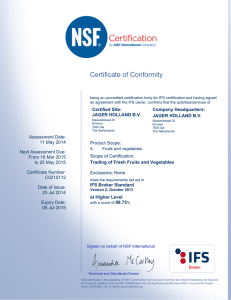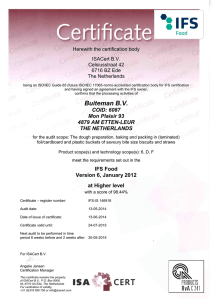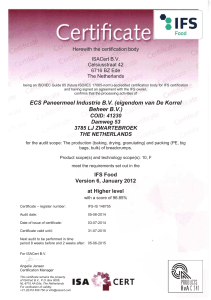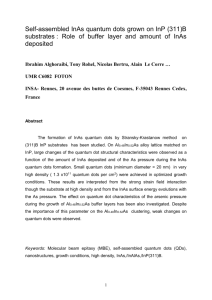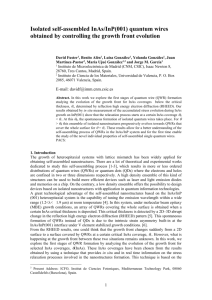Optoelectronic properties of InAs/GaSb superlattices
advertisement
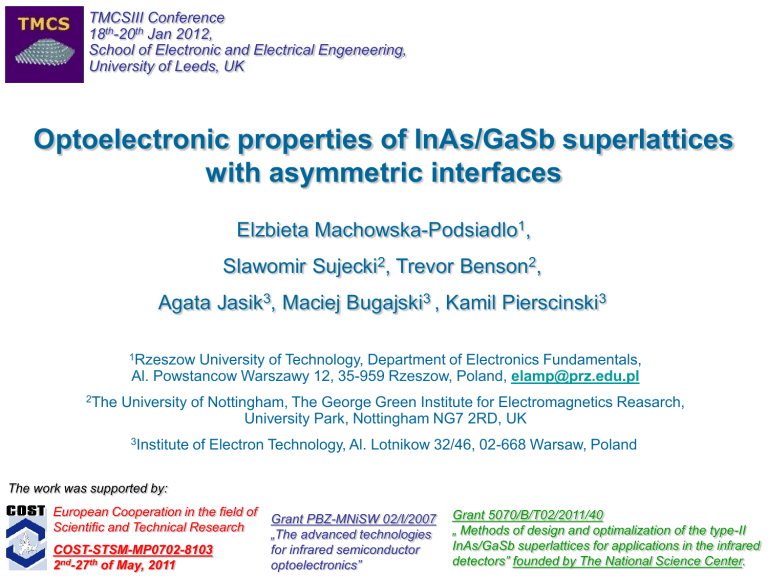
TMCSIII Conference
18th-20th Jan 2012,
School of Electronic and Electrical Engeneering,
University of Leeds, UK
Optoelectronic properties of InAs/GaSb superlattices
with asymmetric interfaces
Elzbieta Machowska-Podsiadlo1,
Slawomir Sujecki2, Trevor Benson2,
Agata Jasik3, Maciej Bugajski3 , Kamil Pierscinski3
1Rzeszow
University of Technology, Department of Electronics Fundamentals,
Al. Powstancow Warszawy 12, 35-959 Rzeszow, Poland, elamp@prz.edu.pl
2The
University of Nottingham, The George Green Institute for Electromagnetics Reasarch,
University Park, Nottingham NG7 2RD, UK
3Institute
of Electron Technology, Al. Lotnikow 32/46, 02-668 Warsaw, Poland
The work was supported by:
European Cooperation in the field of
Scientific and Technical Research
COST-STSM-MP0702-8103
2nd-27th of May, 2011
Grant PBZ-MNiSW 02/I/2007
„The advanced technologies
for infrared semiconductor
optoelectronics”
Grant 5070/B/T02/2011/40
„ Methods of design and optimalization of the type-II
InAs/GaSb superlattices for applications in the infrared
detectors” founded by The National Science Center.
2/12
MOTIVATION
Efforts to replace the currently used HgxCd1-xTe alloys
(MCT - Mercury-Cadmium Telluride) for infrared
radiation detection with superlattices made of III-V alloys
(InAs/GaSb, InAs/InxGa1-xSb).
Advantages of the type-II superlattices:
- better structural stability of the material,
- greater uniformity of the structure as compared to MCT alloys – the
possibility to form the Focal Plane Arrays (FPA),
- compatibility with the III/V materials technology,
- possibility to detect IR at high temperatures,
- the lack of the toxic elements like mercury (Hg) and cadmium (Cd).
The need
to know
the SL band
structure
3/12
OUTLINE
• Band diagram and parameters of the type-II superlattices.
• SL structure - possible types of IFs.
• The four-band Kane model CB-HH-LH-SO and kp method,
the nonparabolicity effects, strain built-in the SL structure, HH-LH states mixing at the IFs of the SL.
• Results
- Parameters of the calculations, transition energies for the SLs with different thickness of
the layers;
- Influence of the band offset energy on the absorption edge of the SLs with symmetric and
asymmetric IFs;
- Influence of the number of „InSb-like” IFs in the SL on the band structure and
transition energy;
- Calculated cut-off wavelength and the PL spectrum measured for (InAs)10/(GaSb)10 x30
SL sample with two types of IFs in the structure.
• Summary.
4/12
Band diagram and parameters of the type-II superlattice
Type II superlattices
InAs
InAs GaSb
953.3meV
meV
GaSb
Type I superlattices
InAs
GaAs
T=0K
AlxGa1-xAs
CB
CB
CB
140meV
0
Eoffset
HH1
LH
VB
HH2
410meV
2.4 3.6nm
2b
2a
EG
EG
813.3 meV
1.42 eV
absorption
edge
Ecut-off
offset
wavelength
EG
1.80 eV
x 0.3
VB
EG
410 meV
2.4 3.6nm
Ioffe
PhysicoTechnical
Institute
Russian
Academy
of Science
T=0K
T=77K
EG InAs
EG GaSb
410 , 415
813.3
414 , 404
800
Eoffset
140, 150
129
204
InAs
GaSb
380
752
387.7
764.3
410
800
F. Szmulowicz,
PRB 69, 2004
E. Plis,
2007
T=300K
350, 356
726, 725 , 725-736
F. Szmulowicz, Eur.
J. Phys. 25, 2004
SL structure – possible types of IFs
SL with symmetric IFs
Ideal SL - influence of the IFs
neglected
InAs
GaSb
z
noncommon
atom SL
„GaAs
like” IF
y
„InSb
like” IF
x
„normal growth sequence”
(InAs‒on‒GaSb)
. . .‒Sb‒Ga‒Sb‒Ga‒As‒In‒As‒In‒ . . .
. . . ‒As‒In‒As‒In‒Sb‒Ga‒Sb‒Ga‒. . .
„inverted interface”
(GaSb‒on‒InAs)
[R. Magri, A. Zunger, PRB 65, 165302, 2002]
SL with
asymmetric
(mixed) IFs
5/12
6/12
The four-band Kane model CB-HH-LH-SO and kp method
Total wave function in each layer:
u1 1 / 2,1 / 2 iS
CB
4
r, k || j z u j r exp i k || r||
u2 3 / 2,3 / 2 1 / 2 X iY
HH
j 1
u3 3 / 2,1 / 2 1 / 6 X iY 2 Z
LH
u4 1 / 2,1 / 2 1 / 3 X iY Z
SO
r r|| , z ; r|| x , y ; k || k x , k y
k z i / z
Ec A
3
Ev P Q
3 *
2U
S * iT z
1 / 2 S * 2T z
U
2U
S iT z
Ev P Q
2Q i 2Qkz
CB z
CB z
z
1 / 2 S 2T z HH z
E HH
LH z
2Q i 2Qkz LH z
Ev P
SO z
SO z
U
In the model:
Masses of holes (HH, LH, SO) are different in both SL layers
Effect of narrow InAs bandgap is considered (nonparabolicity effect)
mHH ,LH z m0 / 1 2 2
mSO z m0 / 1
mel z, E
[G. Liu, S.L. Chuang, PRB 65, 165220, 2002]
[F. Szmulowicz F., H. Haugan, G.J. Brown, PRB 69, 155321, 2004]
7/12
The four-band Kane model CB-HH-LH-SO and kp method
The model takes into account:
Strain effects
T H xy a0 / 3
HH-LH states mixing at the IFs of the SL
Ec A
3
Ev P Q
3 *
2U
S * iT z
1 / 2 S * 2T z
U
CB z
CB z
z
1 / 2 S 2T z HH z
E HH
LH z
2Q i 2Qkz LH z
z
z
Ev P
SO
SO
2U
U
S iT z
Ev P Q
2Q i 2Qkz
InAs
tension
z
x
`
a0
`
GaSb
`
a0
compression
`
`
ac , av , b
Bir-Pikus
potentials
substrate; a0 aGaSb 6.09593 A
[G. Liu, S.L. Chuang, PRB 65, 165220, 2002]
[F. Szmulowicz F., H. Haugan, G.J. Brown, PRB 69, 155321, 2004]
Results – parameters of the calculations, transition energies
(InAs)m/(GaSb)n x 20
m=n=
{8, 10, 12} ML
8/12
Discretization mesh
x 30
8/8 ML N = 4
10/10 ML N = 5
12/12 ML N = 6
x 40
SLs with every 2nd „InSb-like” IF in the structure
N=8
N = 10
N = 12
z=2ML z=1ML
Energy of HH1-CB1 transition
Number of nodes in the mesh
Number of periods
Cut-off wavelength
4.46mm
T=0K
Good agreement with:
[E. Plis et al., IEEE Jour. of Sel. Top.
in Quant. Electr., 12 , 1269, 2006]
4.27mm 8/8 ML, measured at 77K
various number of SL periods
(PL spectra, pseudopot. method calculat.).
T ↑ EHH-CB ↑ l ↓
T=0 → T=77K
EHH-CB 6meV; lcut-off -0.1mm
9/12
Results – influence of Eoffset
on the absorption edge of the SLs with symmetric and asymmetric IFs
Energy of HH1-CB1 transition
Only „GaAs-like” IFs
7.4meV
Every 2nd „InSb-like” IF
Only „InSb-like” IFs
7.2meV
7.0meV
8.0meV
7.9meV
7.7meV
8.2meV
8.3meV
8.1meV
Cut-off wavelength
Eoffset=140meV
0.2mm
Eoffset=150meV
8/8 ML
10/10 ML
12/12 ML
30 periods
z=1ML
0.3mm
The shift caused by
the change of the offset;
78meV
0.1mm
0.10.3mm
10/12
Results – influence of the number of „InSb-like” IFs in the SL
on the band structure and transition energy
10/10 ML
Energy of the miniband edge
ECB, EHH, ELH
4th
every
InSb IF
only
GaAs
IFs
every 2nd
InSb IF
30 periods, z=1ML
Eoffset=140meV
only
InSb
IFs
Hxy=580meV
Energy of HH1-CB1 transition
every 4th
InSb IF
every 2nd
InSb IF
only
GaAs
232.5meV
IFs
231.2meV
only
InSb
IFs
Results – calculated cut-off wavelength and
measured PL spectrum for (InAs)10/(GaSb)10x30 superlattice
10/10 ML
10/10 ML
T=0K
30 periods
30 periods
Calculated cut-off wavelength
every 4th
InSb IF
every 2nd
InSb IF
T=10K
Measured PL spectrum
5.30mm
233.87meV
only
InSb
IFs
5.33mm 5.36mm
only 232.5meV 231.2meV
GaAs
IFs
T ↑ EHH-CB ↑ l ↓
T=0 → T=77K
EHH-CB 6meV; lcut-off -0.1mm
Institute of Electron Technology, Warsaw
Agata Jasik - MBE growth of the SL sample and
Kamil Pierscinski - PL spectrum measuremets
(FTIR spectrometer)
11/12
12/12
Summary
- kp method and the four-band Kane model CB-HH-LH-SO
(which takes into account the nonparabolicity effects, strain built-in the SL and HH-LH
wavefunctions mixing at the IFs in the structure)
allow to calculate the energy band structure of the SLs with symmetric and asymetric IFs
and allow to determine the edge of the absorption of such structures.
- Results of calculations are sensitive to the density of nodes in the discretization mesh –
simulations should be performed with the mesh nodes distanced by 1ML rather than 2ML.
- The change of Eoffset from 140 to 150 meV shifts the energy of HH1-CB1 transition
of the SLs with symmetric and asymmetric IFs by about 7-8meV
which gives the shifts of the cut-off wavelengths by about 0.1-0.3mm.
- Good agreement of the calculated cut-off wavelength 5.36mm (EHH-CB=231.2meV) and
the absorption edge found from the experimental data (lcut-off=5.30mm, EHH-CB=233.87meV)
which were obtained for (InAs)10 /(GaSb)10 x 30 superlattice.
The SL sample was grown in the MBE equipment and the PL spectrum was measured
with the use of FTIR spectrometer at The Institute of Electron Technology in Warsaw.
Thank you for the attention.
